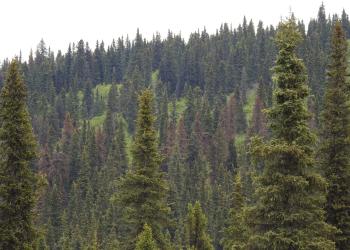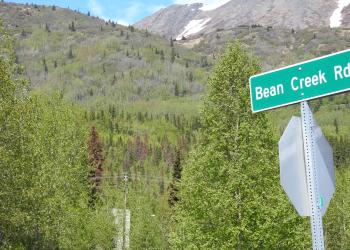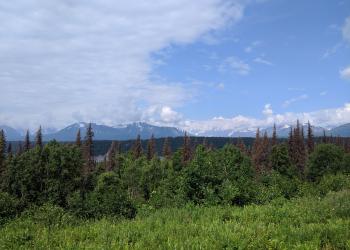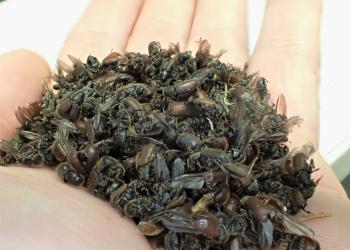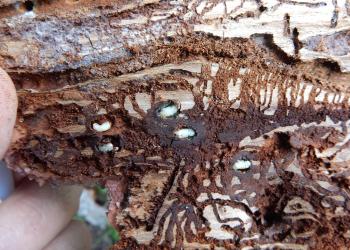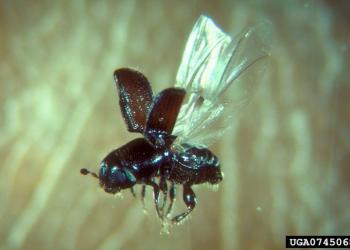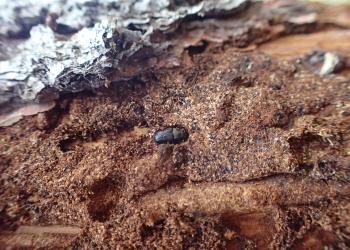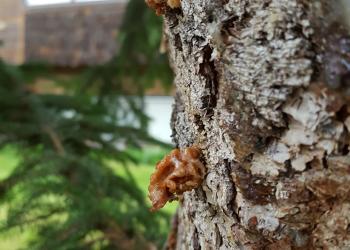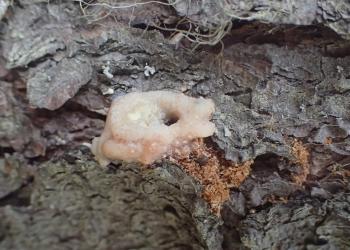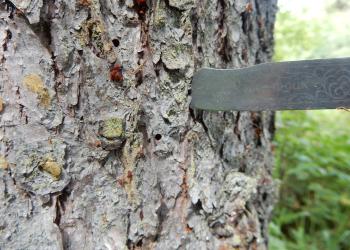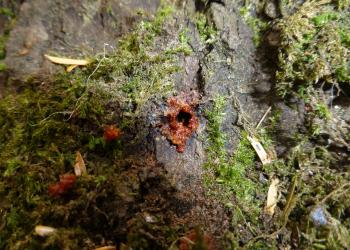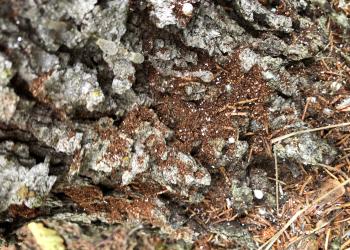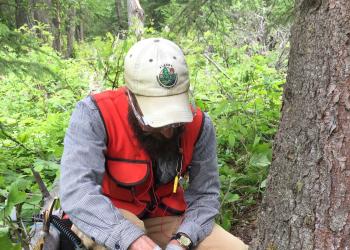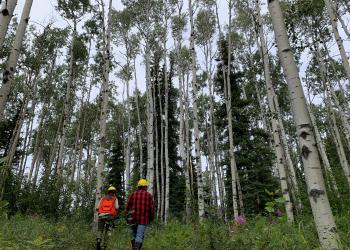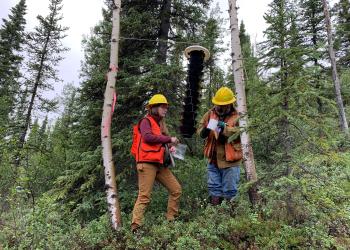Spruce Beetle
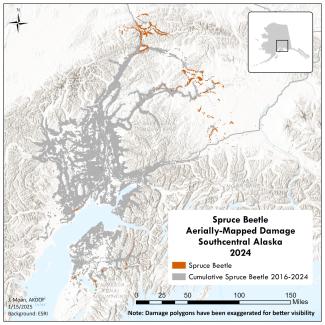
Cumulative area impacted by the spruce beetle outbreak in Southcentral Alaska 2016-2024.
Photo Credit: Map created by Jason Moan AKDOFDendroctonus rufipennis (Kirby)
Host(s) in Alaska:
White spruce (Piceae glauca), Lutz spruce (P. glauca x sitchensis), Sitka spruce (P. sitchensis) and at times black spruce (P. mariana).
Habitat(s): phloem, inner bark and bark
Current Status (2024 Update)
Spruce beetle activity was down considerably statewide in 2024. The 35,100 acres of damage mapped is the least observed in a given year since 2015, the year before the spruce beetle outbreak was initially detected. Despite this overall decline, the spruce beetle outbreak has now impacted a cumulative 2.25 million acres since 2016. Outbreak level activity continues to be observed within the Denali and Matanuska-Susitna Boroughs (14,640 and 14,915 acres respectively) and to a lesser extent in parts of the western Copper River Census Area (925 acres). Activity in the Kenai Peninsula Borough, however, dropped more than 90% from that observed in 2023 (2,025 acres). Spruce beetle activity within the Anchorage Municipality was negligible, with only 30 acres with damage mapped.
Spruce beetle is the most significant insect mortality agent of mature spruce in Alaska. Two outbreak events have altered the forests of Southcentral Alaska in the last 40 years
- An outbreak that started in the 1980s and continued until 2003 affected over 3.2 million acres of forest with >90% of the trees killed in many stands. This outbreak largely occurred on the Kenai Peninsula, on the west side of Cook Inlet, and in the Copper River Census Area and was the largest insect-caused mortality event at the time. This massive spruce beetle outbreak has been attributed to both an aging forest with high-density stands of large-diameter, slow growing spruce, and consecutive warm summers that enabled the spruce beetle to proliferate while leaving drought stressed trees susceptible to beetle attack. Werner et al. 2006 provides a valuable summary of 30 years of spruce beetle research in Alaska.
- The current, ongoing outbreak (first detected in 2016) has affected at least 2.25 million acres of forests as of 2024, largely in the Matanuska-Susitna Borough, Denali Borough, Kenai Peninsula Borough, and Copper River Census Area. The cause(s) of this outbreak are still being determined, but the summers preceding the outbreak and the early years of the outbreak were characterized by warmer temperatures and overall longer growing seasons. Preliminary inventories of forests impacted in the current outbreak confirm upwards or 80% mortality in susceptible size spruce in impacted stands. Inventories also show advanced regeneration in stands with seedling, sapling, and pole timber sized trees in the understory.
Dendrochronology studies have found evidence of major spruce beetle outbreaks in Southcentral and Southwest Alaska in the 1810s, 1870s, 1910s, and 1970s and were synchronous across the period of record. These outbreaks tended to occur following one or more years of warmer and drier than average summer conditions.
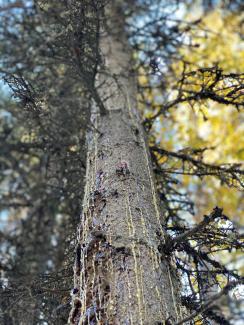
Streaming pitch and pitch tubes in spruce in Far North Bicentennial Park in Anchorage in September 2021.
Photo Credit: USDA Forest Service photo by Steve Swenson.The primary indication that beetles are attacking a tree is reddish-brown dust which accumulates on the bark, in bark crevices, and on the ground beneath the attacked tree. Globules of resin or pitch tubes at the entrance hole into the bark are another sign of beetle attack. Entrance and exit holes are usually found in the roots (both exposed and underground) and lower fifteen feet of the trunk. Early detection requires close examination of trees from early June to mid-July. To determine if spruce beetles are present, remove the bark around an entrance hole to locate the adult and larval tunnels. Beetle infested trees are often sought out by woodpeckers. Pieces of bark chipped away by the woodpecker accumulate on the ground beneath the trees. This is especially noticeable in the winter when the bark accumulates on the snow.
A change in foliage color is another indication of spruce beetle attack. Needles begin to fade from dark green to pale yellowish-green one year after attack and to reddish-brown the following summer. In some cases, needle discoloration may not be noticeable until one year after the attack and sometimes not until after the beetles have left the tree. By mid-summer, one year after initial attack, many needles have dropped and the tree turns reddish-brown. Three to five years following attack, the trees appear silvery-gray and remain that way for many years.
The spruce beetle has a one- or two-year life cycle in Alaska. Adult beetles emerge from infested trees from mid-May to mid-June, and their flight to fresh host materials lasts until mid-July. When the female beetle finds a suitable host, she bores into the bark and constructs an egg gallery in the phloem parallel to the wood grain and usually above the entrance hole. After mating occurs, the female lays whitish-yellow eggs in clusters on either side of the gallery. Eggs hatch into white grub-like larvae which feed in the phloem cross-wise to the egg gallery. Larvae do not enter the wood but may score the outer surface. One-year life cycle beetles develop from egg to pupae the first summer. New adults spend the winter under the bark at the base of the infested tree. Two-year life cycle beetles spend the first winter as larvae beneath the bark. In spring they resume development and eventually transform into white pupae for a short time and then to adult beetles. The adults then migrate to the base of the dead or dying tree where they overwinter.
When beetle populations are high, spruce beetles are known to occasionally attack non-spruce conifers. During the current outbreak, spruce beetles have been found attacking Siberian larch and several species of pine trees, including Scots pine, jack pine, and lodgepole pine, in planted settings. Additionally western hemlock was observed with spruce beetle attacks in forest settings. Often, attacks in these non-host trees are unsuccessful. In several instances, beetles were extracted from non-host trees and sent to taxonomists, who confirmed the beetles were spruce beetle and not another species. We have not observed mortality in non-spruce hosts.
Several recent studies have been conducted to improve tree protection products for use against spruce beetle. During the current outbreak, there has been a renewed focus on looking into ways to use the spruce beetle anti-aggregation pheromone (MCH) to protect trees. Additional efforts have included investigating the use of injectable systemic products against spruce beetle.
Summary of Injection trials
In 2018 trees were treated with formulations of emamectin benzoate (EB) and abamectin to determine the effectiveness of systemic insecticides for protecting trees against spruce beetle. Prior work indicated effectiveness of emamectin benzoate products but abamectin had not previously been tested, and no test had occurred in Alaska’s growing conditions. By the final mortality checks in 2021, approximately 90% of trees treated with EB had been killed by spruce beetle and over 70% of trees treated with abamectin had died. These numbers are consistent with the number of control trees that also died due to spruce beetle activity. More work is needed to refine application timing and techniques for this approach to be effective and recommended.
Summary of MCH trials
Several studies have been completed since 2018 to determine an anti-aggregation product that will work against spruce beetles in Alaska. The initial goal of the work was to determine additional semiochemicals that would enhance MCH’s effectiveness as a repellant. Several semiochemicals intended to “mask” spruce trees or mimic the presence of competing insects have been tested, along with testing varying doses of MCH. As of 2024 results are promising for some of the combination products we’ve tested. Early failures during this outbreak may be due to extremely high beetle populations. Semiochemical control has limitations during extremely high populations because synthetic forms of pheromones will never be as good as their naturally occurring counterparts. Ongoing work will confirm accurate doses for effective tree protection and recommendations for single tree and/or area-wide protection.
The interagency website www.alaskasprucebeetle.org provides detailed management guidance for forest managers, landowners, and homeowners.

Spruce beetle-killed trees in the Cantwell area in July 2021.
Photo Credit: USDA Forest Service photo by Dr. Sydney Mullen.Activities that disturb spruce forests and trees can contribute to spruce beetle attack and outbreaks. These activities include timber harvest, land clearing, severe winds, and wildfire. Spruce beetle attacks may be prevented or reduced by following these guidelines:
Monitor and maintain tree and stand health.
- Remove slow-growing, diseased, damaged, and dying trees promptly.
- Avoid wounding trees unnecessarily during construction and landscape activities.
- Monitor for signs of spruce beetle activity and be prepared to take management actions.
Time management activities to avoid spruce beetles.
- Avoid cutting spruce trees during the adult spruce beetle flight period between May and July.
- Trees cut in the early spring (March through April) should be removed or processed as soon as possible after felling to reduce the risk to standing trees.
Process material to limit spruce beetle habitat.
- Process, debark, or utilize actively infested spruce material.
- Burn, bury, chip, or debark slash and cull logs greater than 4 inches in diameter during timber operations.
- Cut stumps as low to the ground as possible.
Protect high-value spruce trees.
- Apply preventive pesticides to protect trees from successful spruce beetle attacks.
- Consult your local Cooperative Extension office for more information or work with a Certified Pesticide Applicator.
- Additional information on preventive pesticides can be found at www.alaskasprucebeetle.org/pesticides/.
Holsten, E.H.; Their, R.W.; Munson, A.S.; Gibson, K.E. 1999. The spruce beetle. Forest Insect and Disease leaflet 127. Washington, DC: U.S. Department of Agriculture, Forest Service. 12 p. Available here.
Werner, R.A.; Holsten, E.H.; Matsuoka, S.M.; Burnside, R.E. 2006. Spruce beetles and forest ecosystems in south-central Alaska: A review of 30 years of research. Forest Ecology and Management 227: 195-206. Available here
Werner, R.A. Revised by Kruse J, Lisuzzo, N. 2006. The Spruce Beetle in Alaska Forests. USDA Forest Service, Alaska Region, State and Private Forestry. Available here.
Annual Forest Health Conditions Reports are available here.
Life Stages
Signs & Symptoms
Trapping and other work
For more information, contact Jessie Moan, Entomologist, U.S. Forest Service, at Mary.Moan@usda.gov.







